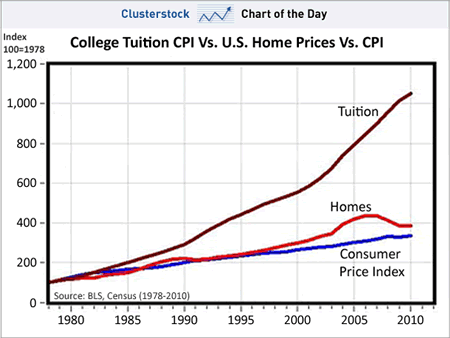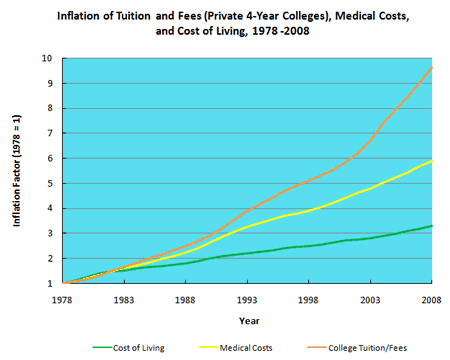Economic mobility has frequently been tied into higher education. Oh sure there are stories of college dropouts like Bill Gates and Steve Jobs being successful without a college degree but for most of us our lifetime earning power is related to the amount of education we receive. Just as we recently saw home ownership become priced out of the range of many young families are we seeing higher education being priced out of the range of more of our young people? Will the online learning opportunities create new ways to become self educated?
I recently read a blog on this topic that I want to share. It comes from "My Money Blog."

While housing went up 4x at its peak (~400), college tuition has gone up over 10x. Instapundit Glenn Reynolds says the higher education bubble is about to burst:
It’s a story of an industry that may sound familiar. The buyers think what they’re buying will appreciate in value, making them rich in the future. The product grows more and more elaborate, and more and more expensive, but the expense is offset by cheap credit provided by sellers eager to encourage buyers to buy.The college tuition prices being tracked in the chart was done by the CPI for US cities for “College Tuition and Fees”. According to this BLS.gov link, this tracks actual expenditures by households, and not some measure of median college tuition, which is often just the “retail price” before various forms of financial aid and/or scholarships.
Buyers see that everyone else is taking on mounds of debt, and so are more comfortable when they do so themselves; besides, for a generation, the value of what they’re buying has gone up steadily. What could go wrong? Everything continues smoothly until, at some point, it doesn’t.
Yes, this sounds like the housing bubble, but I’m afraid it’s also sounding a lot like a still-inflating higher education bubble. And despite (or because of) the fact that my day job involves higher education, I think it’s better for us to face up to what’s going on before the bubble bursts messily.
Another hot topic is the rapidly rising cost of health care. Well, college tuition CPI beats that too, from this Wikipedia chart:

In my humble opinion, it also seems obvious that this trend can’t survive forever. But will it burst like a bubble? Perhaps if the government turns off the loans suddenly, but that seems unlikely. I like Reynold’s idea that there may be an educational revolution with the internet, online coursework, and changing educational standards.
P.S.
Feeling Green? Check out some events to advocate for a greener world from the Climate Change Initiative of Howard County folks.
Sunday, Nov 6 - 2 to 5:30 pm, Rally in Lafayette Park and Joining Hands with thousands to surround the White House asking Obama to reject the Keystone XL tar sands pipeline. Music at 1:30pm, Bill McKibben and speakers. No arrests this time - just a large presence to convince our President to decide against Dirty Oil! Join a carpool from the Meeting House (Oakland Mills Interfaith Center) parking lot against the trees meeting at noon. (rsvp please with your name and phone no) www.tarsandsaction.org
NOTE there is a gathering the night before, Sat Nov 5 from 5-9pm at All Souls Unitarian in DC for a campaign update/strategy session and to meet activists from all over the country. Email if you want to carpool (hococlimatechange@gmail.com) to this also.
Wed, Nov 16 - 6:30 to 8:30 pm Maryland League of Conservation Voters State Legislative Preview at the Randallstown Community Center. 3505 Resource Drive, Randallstown, MD 21133. Maryland Offshore Wind is a one of several important priorities. Email to get info. on Howard County carpools.
Mon,Nov 21 - 7:30 pm Howard Council Council Legislative Session - Testimony on green building residential tax credit bill -Banneker Room, George Howard Bldg. Also Nov3 to Dec 13 Town Halls Supporting Maryland Offshore Wind around Maryland. Email if you want to carpool. We will attend as many as we can to help convince key Md legislators. We are especially planning to support Baltimore Town Hall on Wed Dec 13. We also plan to rally in Annapolis for Offshore Wind on Wed Jan 11 at noon when the legislature opens - save the date!
***************
CCIHC Advocacy Team meeting - Mon Nov 14 at 7 pm at Betsy’s, 6180 Devon Dr - rsvp appreciated 410-730-7740

2 comments:
Yes,we are agree with you,Schools, administrators, and teachers are already feeling the effects of this economic.
awesome!!!!!!!!!!!1
Post a Comment